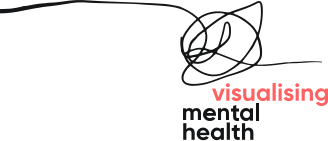Visualising Mental Health Update – April 2021
A quick update for the 2021 projects.
It all kicked off when we gave students the topic for the year, on resilience. We asked them to pick a target population, identify a stressor that population faces and then consider where in the process they’d like to support that population and how.
- Who are you targeting and why?
- What is (are) the stressors/ adversity that impact this group and for which you intend to make them more resilient
- When are you targeting them (pre, during, post stressor, ongoing)
- For pre-emptive interventions, how are you going to convince people who have yet to experience the stressor to prepare for it?
- What are you hoping will change in these individuals that will make them more resilient? (i.e. what resilience factors are you modifying?)
- How will these changes make these individuals more resilient
They had a week to consider these questions before the design studios.
A design studio is where student groups sit together with their lecturers/tutors (Lynda, Luke, Doreen) and start drawing and mind-mapping their ideas. As the participating psychologists (this year, Richard, Simeon and myself), we visit each group separately and help them both understand the topic but also add some fuel to their fledgling ideas (if they are good ones) or pour a bit of water on those that don’t quite cut it.
I enjoy these sessions because they are tangible examples of co-design. Two different professions coming together to create concepts and ideas that neither profession could realistically envision just on their own. As an aside, I’ve noticed that the lecturers/tutors, who have all been involved in this project for a while (in different ways, one even as a student) now have great instincts as far as mental health themed projects go. Sometimes I find myself nodding in agreement as they describe a psychological concept far better than I could. This is one of the other benefits of co-design. Each profession starts to develop literacy in the other field(s). So my design instincts are much better than before I started this project. Likewise, their psychology instincts are much better now, than when the project first started.
So that is the design studios.
Then a couple of weeks back, we held Zoom sessions (Lecturers/tutors + Richard, Sarah, myself). During these sessions, student groups had to do ultra rapid presentations of three different concepts they had come up with. It is a good test for the student groups on multiple levels. First, they have to practice the art of presenting. Second, they have only a short period of time to present, so have to be quite articulate and precise in the way they describe their ideas. Third, they have to try and capture and then organise quite a bit of rapid feedback that is given.
Despite the ‘zoom fatigue’ that many people are feeling, these sessions are actually really good and likely to stay a part of the process, even in years where it isn’t required. They mimic the real world, where designers have to regularly touch base with clients to give them updates on a project and showcase new ideas. Zoom is a great place for this because of the capacity to share the screen, but also pull together a meeting quickly with people in varied locations.
So where is it at now?
Right now, those students are in a stage of rapid production, taking the ideas and feedback of the past few weeks and turning into a final prototype/idea (well actually, they are on mid semester break at the moment, so maybe not ?) The next time we see them, they’ll be giving their final presentations as well as submitting a video brief that attempts to showcase their final idea in the best way possible. They are still allowed to reach out to the participating psychologists in the meantime however.
In my next post, I am going to showcase a couple of ideas from last years’ group.
Till then, take care
Dr G

